This Trip of the Month is not an excerpt from one of our
Guides, but will be included in future Guides so that you can find the best spots
for
great blooms in both regions. Different types of soil and other conditions
within a particular region produce different types of flowers.
Anza-Borrego State Park
Most of the wildflowers in Anza-Borrego can be seen from paved
roads and many other blooms are located via dirt roads that don't require 4WD.
For up-to-date information on where the flowers are blooming, check out the
State Park's
special website or their
main website.
 See Map
See Map
Two significant blooms of both the Desert Sand Verbena and the Desert Sunflower
can be seen along a 3 mile stretch of Henderson Canyon Road. This area is
just west of the intersection of Henderson Canyon Road and County Route S-22.
All around the park are large blooms of the Brown-Eyed Primrose.
These can be seen in most places, however one of the best spots we found was
around the Borrego Mountain area. Also found around Borrego Mountain,
specifically Hawk Canyon, were large fields of purple Lupine.
Coyote Canyon is another great place to see many different types
of wildflowers in bloom. Although the blooms here are not as large as the
ones along Henderson Canyon Road, the expanse of Coyote Canyon offers many
varieties of flowering plants.
A spectacular but non-native flower bloom can be seen at the La
Casa del Zorro resort outside of Borrego Springs. See
their website for
more details.
 |
Purple Desert Sand Verbena seen on the west side of Di
Giorgio Road. Borrego Palm Canyon is in the background. |
 |
Close-up of a Dune Evening-Primrose. You can still
see the morning dew
on the petals. |
 |
Another close-up of a Dune Evening-Primrose, but in
subdued light. |
 |
A cluster of Dune Evening-Primroses. |
 |
The many flowers along Henderson Canyon Road. Where
there is sand, as seen in this picture, you will likely see Sand
Verbena and the Dune Evening Primrose. |
 |
More flowers along Henderson Canyon Road. |
 |
Fields of Desert Sand Verbena can be found on the
east end of Henderson Canyon Road. |
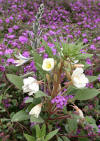 |
Here we see three flowers: the Dune Evening-Primrose,
Desert Sand Verbena and an early Desert Lily. The
lilies are more common around April. |
 |
The impressive Desert Sunflower bloom along Henderson Canyon
Road. |
 |
This picture demonstrates the size of the bloom.
The area covers an area roughly one mile wide by two miles in length. |
 |
There are acres of yellow blooms! |
 |
This 360° animated panorama shows
the size of the Henderson Canyon Road bloom.
Note that this is a large file and may take between 30
seconds and a couple of minutes to load. |
 |
A typical scene in Coyote Canyon right now: a multitude of colors
mixed in with various types of cactus. |
 |
We think this is a Scarlet Milkvetch or Scarlet
Locoweed. This was found near the second river crossing in Coyote
Canyon. |
 |
Indigo Bush also found near the second crossing. |
 |
Close-up of the Indigo Bush's blooms. The seed
pods seen in the lower left look like little Easter eggs. |
 |
This small "pincushion" cactus is in full bloom already.
They were plentiful after the third river crossing and just before the
road becomes very rough. |
 |
Here is some Desert Dandelion. |
 |
Brittlebush is plentiful throughout the Mojave and
Sonora deserts. One of the best and easiest places to enjoy them
is along I-15 between Victorville and Las Vegas. |
 |
This big Brittlebush is found at the beginning of the
Lower Willows hiking trail at the third crossing in Coyote Canyon. |
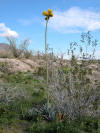 |
This Agave Desertii was blooming early for
February. Normally, you can spot many of these tall blooms around
May. |
 |
A close-up of the Desertii's bloom. |
 |
There was a magnificent bloom of lupine in Hawk Canyon
located in Borrego Mountain. |
 |
Lupine with the rocks of Hawk Canyon in the background. |
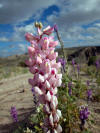 |
A rare pink lupine. If you look around the lupine
fields long enough, you will probably find one. |
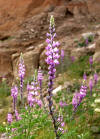 |
Lupine look even better when they are backlit by the
sun. |
 |
All around Borrego Mountain you can find fields of Brown-eyed Evening-Primrose. |
 |
These Primroses were near The "Slot" - a slot canyon in
Borrego Mountain. |
 |
Close-up of some weather beaten Primroses. It
rained quite heavily the day before this picture was taken. |
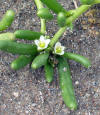 |
This small, mysterious succulent was found in abundance near
The "Slot". |
 |
The non-native yellow and orange flowers planted around
the La Casa del Zorro resort. |
 |
The flowers seem to go on forever. |
 |
Close-up of the flowers. |
Death Valley National Park
Like Anza-Borrego, most of the wildflower blooms in Death Valley
can be seen from paved roads. Most of the blooms are found along Badwater
Road in the southern portion of the park around Ashford Mill.
There are other blooms occurring all around the park. For
up-to-date information on where the flowers are blooming, check out Death
Valley's
special website
or their main
website. Thanks to the fact that water runs-off and collects near
paved roads, some of the best blooms are right along side.
 See Map
See Map
Death Valley usually receives less than 2 inches of rain per
year but, beginning in August of 2004, it has been an exceptionally rainy year.
It has rained steadily throughout the winter which means wildflowers will
probably be blooming until May.
 |
Here is the main actor of the bloom below: the Desert
Sunflower. |
 |
The colorful Black Mountains of Death Valley make for a
great background to this colossal bloom of yellow sunflowers. |
 |
Blankets of yellow flowers are terraced up on the hillside. |
 |
The multi-colored Black Mountains in the foreground and
the 11,000 foot high Panamint Mountains in the background. |
 |
A field of flowers is a little girl's dream! |
 |
The Ashford Mill ruins with the above-normal flow of the Amargosa River
in the background. Notice the hill in the background is covered in
yellow flowers, too. |
 |
Peeking out of Ashford Mill. |
 |
Around Ashford Mill look for the Desert Five-Spot that
are
scattered in with the Desert Sunflowers. |
 |
Close-up of the Desert Five-Spot. |
 |
More fields of Desert Sunflowers are found north of
Ashford Mill with the jagged Black Mountains in the background. |
 |
About one fourth of the way up Galena Canyon's 4WD road,
you'll find a large field of Golden Evening-Primrose.
Galena Canyon is about five miles northwest of Ashford Mill and is
currently difficult to get to without having a 4WD vehicle. |
 |
Golden Evening-Primrose and purple Phacelia along Galena
Canyon Road. |
 |
Desert Chicory found in Galena Canyon. This white
flower is very common throughout the Mojave Desert. |
 |
This very small flower, the Lesser Mojavea, was found at
the top of Galena Canyon. |
 |
The small scale of the Lesser Mojavea is shown in
this picture. |
 |
The reason for the abundance of wildflowers in Death
Valley? Water! |
 |
Since ancient Lake Manly dried up over 2,000 years ago,
the collection of this much water in the Death Valley basin happens
rarely. We've heard that the last time was over 100 years ago!
Normally, the lowest spot in the United States (Badwater),
has no water but this year there is a lake almost 20 miles long and a
few miles wide! |
 |
Driving along S.R. 138, between S.R. 14 and I-5, you'll
see some great poppy blooms. This shot was taken about 10 miles
west of S.R. 14 right along 138 and about 5 miles south of the famous
Antelope Valley Poppy Reserve. Here are very small, yellow daisy-type flowers
called Goldfields with
some California Poppies mixed in. |
 |
Throughout the Antelope and Victor Valley's, there are
literally billions of these very small, Goldfield flowers blanketing the
desert floor. This hill is also along S.R. 138. |
 |
The Calico Mountains near Barstow are also showing a
very good bloom with many different varieties of flowers. |
 |
This patch of sunflowers is in the Calico
Mountains. |
 |
The Mojave Aster was not common in the other desert
regions we have recently visited but was plentiful all over the Calico Mountains
area. |
 |
These Small Desert Stars were also plentiful
around Calico. |
 |
The Brittlebush is blooming in very large quantities on the
south side of the Calico Mountains. This picture was taken at the main opening of
the 1880's era Odessa Mine located in the canyon of the same name. |
 |
This flowering Rock Nettle (a.k.a. Sting Bush) was
found while hiking the trail along Salt Creek Hills located just south of Dumont Dunes
(between Death Valley and the Mojave National Preserve). |
 |
View of the entire Rock Nettle plant. Like its
cousin the Stinging Nettle that's found in wet areas, this type of
nettle also "stings" when you brush against it. |
 |
There was plenty of this very small and delicate Lilac
Sunbonnet along the Salt Creek Hills trail. |
 |
A close-up of the Lilac Sunbonnet. |
 |
Several patches of Desert Star were found along the
Salt Creek Hills trail, too. |
 |
The red arrow in this picture points out a happy bug on this large
Brittlebush found along the Salt Creek Hills hiking trail. |
 |
Don't wait too long to get out and see the wildflowers!
This happy beetle (from the previous picture) finds those
flowers very tasty! |
































































